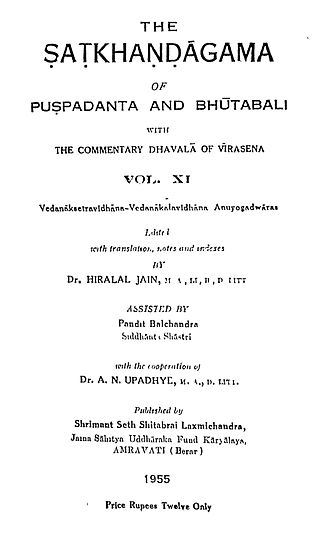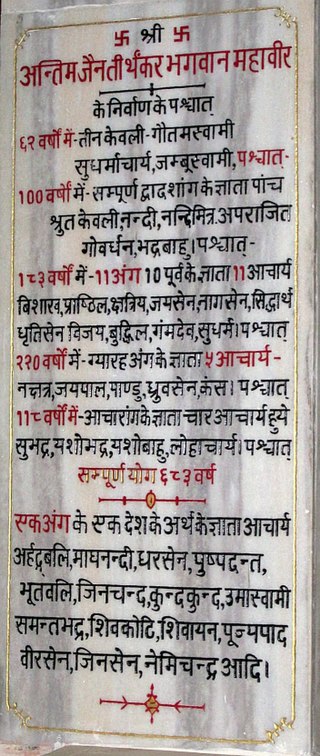Related Research Articles

Chandragupta Maurya was the first emperor of the Mauryan Empire in Ancient India who expanded a geographically extensive kingdom based in Magadha and founded the Maurya dynasty. He reigned from 320 BCE to 298 BCE. The Maurya kingdom expanded to become an empire that reached its peak under the reign of his grandson, Ashoka, from 268 BCE to 231 BCE. The nature of the political formation that existed in Chandragupta's time is not certain. The Mauryan empire was a loose-knit empire.
Siddhānta (सिद्धान्त) is a Sanskrit term denoting the established and accepted view of any particular school within Indian philosophy; literally "settled opinion or doctrine, dogma, axiom, received or admitted truth; any fixed or established or canonical text-book on any subject".
Varāhamihira, also called Varāha or Mihira, was an astrologer-astronomer who lived in Ujjain in present-day Madhya Pradesh, India.
Utpala, also known as Bhaṭṭotpala was an astronomer from Kashmir region of present-day India, who lived in the 10th century. He wrote several Sanskrit-language texts on astrology and astronomy, the best-known being his commentaries on the works of the 6th-century astrologer-astronomer Varāhamihira.
Bṛhat-saṃhitā is a 6th-century Sanskrit-language encyclopedia compiled by Varāhamihira in present-day Ujjain, India. Besides the author's area of expertise—astrology and astronomy—the work contains a wide variety of other topics.

The Ṣaṭkhaṅḍāgama is the foremost and oldest Digambara Jain sacred text.

A Pattavali, Sthaviravali or Theravali, is a record of a spiritual lineage of heads of monastic orders. They are thus spiritual genealogies. It is generally presumed that two successive names are teacher and pupil. The term is applicable for all Indian religions, but is generally used for Jain monastic orders.

Sthulabhadra was the founder of Svetambara Jain order during a 12-year famine in Maurya empire in third or fourth-century BC. He was a disciple of Bhadrabahu and Sambhutavijaya. His father was Sakatala, a minister in Nanda kingdom before the arrival of Chandragupta Maurya. When his brother became the chief minister of the kingdom, Sthulabhadra became a Jain monk. He is mentioned in the 12th-century Jain text by Hemachandra.
The Agamas are a collection of several Tantric literature and scriptures of Hindu schools. The term literally means tradition or "that which has come down", and the Agama texts describe cosmology, epistemology, philosophical doctrines, precepts on meditation and practices, four kinds of yoga, mantras, temple construction, deity worship and ways to attain sixfold desires. These canonical texts are in Tamil and Sanskrit. Agamas were predominant in South India but Sanskritized later.
Jain literature refers to the literature of the Jain religion. It is a vast and ancient literary tradition, which was initially transmitted orally. The oldest surviving material is contained in the canonical Jain Agamas, which are written in Ardhamagadhi, a Prakrit language. Various commentaries were written on these canonical texts by later Jain monks. Later works were also written in other languages, like Sanskrit and Maharashtri Prakrit.

Jainism is an Indian religion which is traditionally believed to be propagated by twenty-four spiritual teachers known as tirthankara. Broadly, Jainism is divided into two major schools of thought, Digambara and Svetambara. These are further divided into different sub-sects and traditions. While there are differences in practices, the core philosophy and main principles of each sect is the same.
Arnoraja was an Indian king belonging to the Shakambhari Chahamana dynasty. He ruled the Sapadalaksha country, which included parts of present-day Rajasthan in north-western India. Arnoraja repulsed a Ghaznavid invasion from the west, and also defeated several neighbouring Hindu kings including the Paramaras and the Tomaras. He had to face defeats against the Chaulukyas, and was ultimately killed by his own son, Jagaddeva.
Prabandha-Kosha is an Indian Sanskrit-language collection of prabandhas. It was compiled by the Jain scholar Rajashekhara Suri in 1349 CE. It describes the lives of 24 people, including 10 Jain scholars, 4 Sanskrit poets, 7 kings and 3 Jain householders. It is also known as Chaturvinshati Prabandha.
Prabandha is a literary genre of medieval Indian Sanskrit literature. The prabandhas contain semi-historical anecdotes about the lives of famous persons. They were written primarily by Jain scholars of western India from 13th century onwards. The prabandhas feature colloquial Sanskrit with vernacular expressions, and contain elements of folklore.
Bhadrabahu was a Digambara monk from ancient India. He is called Bhadrabahu II or Bhadrabahu the Junior to distinguish him from the earlier Bhadrabahu.
Vastupāla was a prime minister of the Vāghelā king Vīradhavala and his successor Vīsaladeva, who ruled in present-day Gujarat region of India, in the early 13th century. Although he served in an administrative and military capacity, he was also a patron of art, literature and public works. He, together with his brother Tejapāla, assisted in the restoration of peace in the kingdom, and served in a number of campaigns against Lāṭa, Godraha, Kutch and the Delhi Sultanate. The brothers were instrumental in the construction of the Luniga-vasahi temple on Mount Abu and the Vastupala-vihara on Girnar.
Prabandha-Chintamani is an Indian Sanskrit-language collection of prabandhas. It was compiled in c. 1304 CE, in the Vaghela kingdom of present-day Gujarat, by Jain scholar Merutunga.
In several ancient Indian texts, Nagnajit appears as the name of a king or kings who ruled Gandhara and/or neighbouring areas. Some texts also refer to Nagnajit as an authority on temple architecture or medicine. According to one theory, all these references are to a single person; another theory identifies them as distinct persons.
Samāsa Saṃhitā is a lost work on astrology by the 6th-century astrologer-astronomer Varāhamihira of present-day central India. An abridged version of Bṛhat Saṃhitā, it is known from excerpts in Utpala's commentary on the Bṛhat Saṃhitā.
References
- 1 2 Kailash Chand Jain (1991). Lord Mahāvīra and His Times. Motilal Banarsidass. p. 87. ISBN 978-81-208-0805-8.
- 1 2 3 4 5 6 A.M. Shastri (1991). Varāhamihira and His Times. Kusumanjali. pp. 174–189. OCLC 28644897.